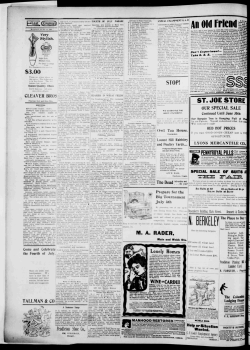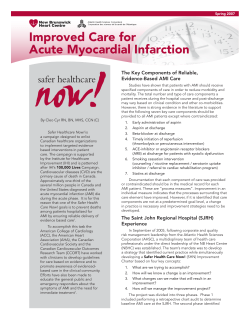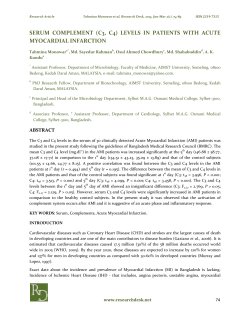
The Beneficial Role of Angiotensin- Converting Enzyme Inhibitor in Acute Myocardial Infarction
The Beneficial Role of AngiotensinConverting Enzyme Inhibitor in Acute Myocardial Infarction Cardiovascular Center, Korea University Guro Hospital 2007. 4. 20 Seung-Woon Rha, MD, PhD Introduction 1. Cardiovascular disease is one of the leading causes of mortality in the world and most of the deaths are originated from the coronary artery disease. 2. Despite the proven beneficial effect of other drugs including aspirin, statin and β-blockers on the coronary heart disease, still the cardiovascular complications remains high. ACE Inhibitors 3. Angiotensin-converting-enzyme (ACE) inhibitors have been introduced for an effective secondary preventive strategy to minimize these cardiovascular morbidity and mortality. 4. Traditionally, ACE inhibitors are known to be effective in reducing morbidity and mortality among patients with heart failure, left ventricular (LV) dysfunction, post myocardial infarction (MI), hypertension and other high risk patients. Role of ACEI in AMI ** Two randomized trials involved patients with moderate to severe LV dysfunction 1) The SOLVD trial (Studies of Left Ventricular Dysfunction) 2) The SAVE trial (Survival And Ventricular Enlargement) Post hoc analysis showed a reduction in the rate of AMI in patients who were treated with an ACE inhibitor. Yusuf S et al. Lancet 1992;340:1173-8 HOPE - (Heart Outcomes Prevention Evaluation) 1. Objective To investigate the effect of Ramipril (Tritace) on the prevention of CV events in high-risk patients 2. Study Design 2x2 factorial, double blind, randomized, placebocontrolled 9,297 patients enrolled 3. Follow-up 4.5 years (visits at 6 months) HOPE Study Investigators. New Engl J Med 342:145-153, 2000 HOPE - Patients 1. Inclusion Criteria Patients (age ≥55) at high risk for cardiovascular events because of - any evidence of vascular disease (CHD, Stroke, PVD) - diabetes with one other risk factor 2. Exclusion Criteria 1) Low EF 2) Current use of ACE-I or Vitamin E HOPE Study Investigators. New Engl J Med 342:145-153, 2000 HOPE – Outcome Measures 1. Primary Endpoint Composite of MI/Stroke/CV death (+ separate analysis of each) 2. Secondary Endpoint Total Mortality, Revascularization, Diabetes Complications 3. Other Endpoint Onset of New Diabetes, Worsening angina/unstable angina, HF(including hospitalisations), Cardiac arrest HOPE Study Investigators. New Engl J Med 342:145-153, 2000 HOPE – Result I: Primary Outcomes RRR(%) CV death 0 MI Stroke -10 -20 -20 -26 -32 -30 All differences p<0.001 HOPE Study Investigators. New Engl J Med 342:145-153, 2000 HOPE – Result II: Secondary Outcomes Revascularization RRR(%) Diabetes Complications 0 -5 -10 -15 -15 p=0.002 -16 p=0.03 -20 HOPE Study Investigators. New Engl J Med 342:145-153, 2000 Effect of Ramipril in HOPE Patients reaching composite endpoint [MI, stroke, CV death] (%) - increasing divergences with time 20 Placebo Ramipril 15 p < 0.001 10 5 Risk reduction 22% 0 0 1 2 3 Years of Follow-up 4 HOPE Study Investigators. New Engl J Med 342:145-153, 2000 HOPE-Result III - significant reduction of new diagnosis of diabetes Cumulative Risk 0.10 Placebo Ramipril 0.08 0.06 34% 0.04 0.02 0 0 1 3 2 Years of Follow-up 4 S. Yusuf et al. JAMA 286:1882-1885, 2001 Ramipril 10mg - Direct dose dependent action of Ramipril on the RAS Role of 10 mg Ramipril: RAS Circulation (Plasma) Local (Plaque) Low ACE-Activity High ACE-Activity Ramipril + ++ ++ 2.5 mg 5.0 mg# 10.0 mg* (+) ++ Antihypertensive * Based on the Clinical Results of the HOPE-Study CV Protective # In Patient with Recommended DoseModification (ex. Renal Dysfunction.) CV Protective Effect was more than by BP Reduction 1. Totally different from other clinical trials in the same effect in both Normotensives and Hypertensives 2. Much higher risk reduction than expected from general BP reduction ACEI Ramipril 10mg - the recent understanding of mechanism Plaque Rupture Early Plaque Statin Thrombus x Vulnerable Plaque a St tin Ramipril 10mg Stabilized Plaque Aspirin Clopidogrel Angina MI Death Across the spectrum of risk • Efficacy beyond blood pressure control • Risk assessment In patients with stable coronary disease, after 4.2 years mean follow up, major cardiac events (death, MI) : 8 - 10% Risk assessment in these patients ? Perindopril benefit at all levels of risk ? Primary endpoint % CV death, MI or cardiac arrest Placebo annual event rate: 2.4% 14 12 RRR: 20% 10 p = 0.0003 Placebo Perindopril 8 6 14% 4 12% 2 10% 0 0 1 2 3 EUROPA Study Investigators Lancet 2003;362:7822003;362:782-788 4 5 Years Diabetes Total death / MI RRR 20% PERSUADE diabetes No diabetes RRR 19% RRR 21% 15,5% 12,6% 9,9% 9,0% 8,0% placebo perindopril 7,4% placebo perindopril placebo perindopril Risk model Risk factors in stable CAD : male diabetes family history CAD age BP stroke/TIA/PAD weight cholesterol no revascularization smoker creatinine Risk model Score Score Age 0-8 PAD/CVD 3 Chol 0-6 Male 2 Weight 0-3 Diabetes 2 Creat 0-3 Smoker 2 Systolic BP 0-2 Fam Hist 1 Revasc -1 Risk model Risk level low mid high 3976 3975 3975 age (year) 57 59 64 Male (%) 78 Pre-MI (%) 41 71 81 Revasc. (%) 73 50 41 133 137 142 3 8 26 99 94 90 n= Syst. BP (mmHg) Diabetes (%) Creatinin level (µµMol/l) 89 90 Treatment effect Consistent risk reduction with perindopril low medium high risk 15.2% 13.5% 9.4% 6.3% 5.0% placebo 4.3% perindopril placebo perindopril placebo perindopril Treatment effect Conclusion Risk factors in stable CAD : male diabetes family history CAD age BP stroke/TIA/PAD weight cholesterol no revascularization smoker creatinin Perindopril treatment benefit consistent across all risk levels ACE inhibition for secondary prevention of CAD Rationale Anti-atherosclerotic effects Plaque rupture reduction Improvement in vascular endothelial function Enhanced fibrinolysis Modulation of neurohormonally-induced arterial vasoconstriction LV hypertrophy reduction Blood pressure reduction Blood pressure Placebo Perindopril 8mg mmHg 140 130 120 110 ∆SBP: 5 mmHg ∆DBP: 2 mmHg 100 90 80 70 -1 -1/2 0 3 6 12 18 24 Months 30 36 42 48 54 60 Are the cardiovascular benefits observed in EUROPA the result of blood pressure lowering or could more specific anti-atherosclerotic effects be involved? Effect of baseline systolic blood pressure on primary endpoint Primary endpoint-risk reduction placebo perindopril 20% RRR 39% RRR 17% RRR 18% 15% 2745 10% 5% 2722 2788 666 2722 No interaction between treatment and SBP: p=0.141 575 0% <120 mmHg >120120- <140 mmHg >140 mmHg SBP Effect of baseline diastolic blood pressure on primary endpoint Primary endpoint-risk reduction placebo perindopril 20% 15% RRR 18% RRR 12% RRR 43% No interaction between treatment and DBP p=0.130 695 10% 3226 2187 3263 2183 664 5% 0% <80 mmHg >80 and <90 mmHg >90 mmHg DBP EUROPA Conclusion Perindopril’s benefit in EUROPA cannot be explained by blood pressure at baseline or blood pressure reduction alone Other mechanisms including direct vascular,antiatherosclerotic effects and improvement of endothelial function of perindopril may play a role PERTINENT (a substudy of EUROPA): PERindopril - Thrombosis, InflammatioN, Endothelial dysfunction and Neurohormonal activation Trial PEACE 1. PEACE Trial (Prevention of Events with Angiotensin Converting Enzyme Inhibition) ; Trandolapril 2. Study population 1) In patients with stable coronary heart disease and preserved LV function who are receiving current standard therapy 2) In whom the rate of cardiovascular events is lower than in previous ACE inhibitor trials in patients with vascular disease PEACE Conclusion In pts with stable coronary heart disease and preserved LV function who are receiving “current standard” therapy and in whom the rate of cardiovascular events is lower than in previous trials of ACEI in pts with vascular disease, ; ACE inhibitor provides no further benefit in terms of death from cardiovascular causes, MI or coronary revascularization. Effect of ACEI in AMI Setting 1. Blood Pressure? 2. Cardiovascular protective effects? 3. LV remodeling? 4. Baroreflex sensitivity? 5. QT dispersion and tachyarrhythmia? 6. Angiogenesis? 7. No-reflow? Angiotensin II 1. increases lipid peroxidation 2. increases oxyradical formation 3. stimulates the expression of proinflammatory genes (chemoattractant protein and leukocyte adhesion molecules) endothelial dysfunction 4. improves vascular smooth-muscle proliferation 5. stimulates the production of PAI-I. Bradykinin 1. counteracts the negative action of angiotensin II 2. improves endothelial function by increasing expression and activity of the constitutive nitric oxide synthase 3. antiproliferative effect; inhibits the expression of monocyte and adhesion molecules 4. stimulates the synthesis of tissue plasminogen activator ACEI and LV remodeling in AMI 1. Inflammatory cytokines play an important role in the pathophysiology of LM remodeling and hs CRP is a predictor of LV remodeling in patients with AMI. 2. ACEI to AMI patients showing increased hs CRP levels during the early stage of the disease could prevent LV remodeling. 3. Early initiation of ACE inhibitor (Perindopril) reduces collagenase activity. ; beneficial effects on post MI remodeling Suzuki H et al. Int Heart J. 2006;47(5):715-25. ACEI and Baroreflex Sensitivity in AMI 1. Depressed barorelex sensitivity after AMI is considered an indication of decreased vagal and/or increased sympathetic tone. 2. ACE inhibitor Captopril (Capril®) appears to improve baroreflex sensitivity in the early phase of AMI. Marakas SA et al. Eur Heart J 1995;16(7):914-21. ACE Inhibitors, Angiotensin II Antagonists, and Platelet Function ACE inhibitors Captopril 25 mg BID Someya et al78 Captopril 25–50 mg BID ADP-induced aggregation Decreased Birkebaek et al79 ADP-induced aggregation, PF4 No change Quinalapril 20 mg BID Gupta et al80 ADP-induced aggregation, PF4 No change Enalapril 10–20 mg Li-Saw-Hee et al81 ADP-induced aggregation, PF4 No change Captopril 25–50 mg Muller et al82 Platelet Enalapril 20 mg Hernandez-Hernandez et al83 ADP-induced aggregation Increased -adrenoceptors Decreased Angiotensin II antagonists Losartan 50–100 mg Li-Saw-Hee et al81 Soluble P-selectin No change Losartan 50–100 mg Pathansali et al91 Megakaryocyte size and ploidy Decreased Bleeding time Increased Aggregation No effect Losartan 100 mg Levy et al84 Losartan and valsartan Kalinowski et al77 Platelet aggregation Decreased NO release in vitro Increased Collagen-induced aggregation Decreased PF4 indicates platelet factor 4; NO, nitric oxide. Blann, A. D. et al. Hypertension 2003;42:1-7 Indication for ACE-Is (US) Reduction in Risk of MI HT HF LVD/HF after MI MI X* X* Benazepril X Captopril X X* Enalapril X X* Fosinopril X X Lisinopril X X Moexipril X Ramipril X Perindopril X Quinapril X Trandolapril X X* No of Agents 10 7 Stroke and Death from Reduction in mortality/morbidity for the indication Cardiovascular Cause V V X* X* V X* V X V 1 5 * includes documentation of improved long-term survival and clinical outcomes compared with placebo Curt D. et al. Circulation 2003:108:2608-2610 ACEI and QT dispersion in AMI 1. A prolonged QT dispersion is a marker of electrical instability predisposing to ventricular arrhythmia and sudden cardiac death. 2. ACE inhibitor Enalapril reduces the degree of ventricular dispersion of repolarization following AMI and sudden cardiac death can be reduced. Kassotis J et al. Pacing Clin Electrophysiol. 2003;26(4 Pt 1):843-8. ACEI and angiogenesis in AMI 1. Intravenous bFGF (basic fibroblast growth factor) may increase VEGF (vascular endothelial growth factor) and bFGF significantly, thus promoting the angiogenesis in the infarct zone and border zone in cardiac infarction as VEGF and bFGF are the potent angiogenic growth factors. 2. ACE inhibitor Benazepril may promote angiogenesis in the infarct zone and border zone in cardiac infarction. Li DY et al. Biomed Environ Sci. 2004;17(4):442-51 ACEI and No-reflow in AMI 1. No-reflow phenomenon has been associated with severe myocardial injury, progressive LV remodeling, CHF and poor prognosis. 2. Pretreatment with ACE inhibitor (Captopril-M/C, Enalapril, Fosinopril) could preserve the microvascular integrity after AMI. Zhao JL et al. Clin. Cardiol. 30.130-134 (2007). Role of ACEI in AMI-Summary1. BP lowering effect 2. Direct cardiovascular protective effects 3. Decreasing LV remodeling 4. Improve Baroreflex sensitivity 5. Decrease QT dispersion 6. Increase Angiogenesis 7. Reduce No-reflow Conclusion 1. The beneficial effects of ACE inhibitors in addition to other preventive measures including aspirin, ßblockers and lipid-lowering drugs were consistent for the patients with AMI in all the previously published literature. 2. These results provide strong support for considering ACE inhibitors in all patients with AMI irrespective of cardiac function or risk factors. Thank You for your attention!! 1. We have learned an incredible amount. 2. We are only limited by our imagination.
© Copyright 2025





















